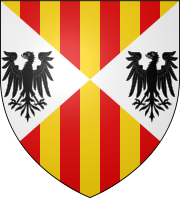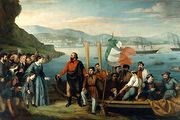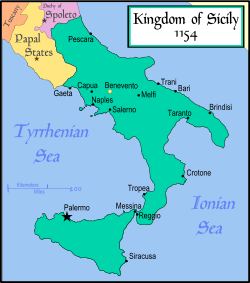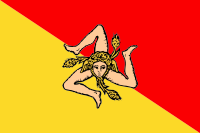Kingdom of Sicily
|
|||||||||||||||||||||||||||||||||||||||
The Kingdom of Sicily (Italian: Regno di Sicilia, commonly abbreviated Regno, Latin: Regnum Siciliae or Sicilie, Catalan: Regne de Sicília, Sicilian: Regnu di Sicilia) was a state that existed in the south of Italy from its founding by Roger II in 1130 until 1861. It was a successor state of the County of Sicily, which had been founded in 1071 during the Norman conquest of southern Italy. The Kingdom covered not only the island of Sicily itself, but also the whole Mezzogiorno region of southern Italy. The island was divided into three regions; Val di Mazara, Val Demone and Val di Noto.
It was sometimes called the regnum Apuliae et Siciliae until 1282. In 1282 a revolt against the Angevin rule, known as the Sicilian Vespers threw off Charles of Anjou's rule of the island of Sicily. The Angevins managed to maintain control in the mainland areas of the kingdom, which eventually became known as the Kingdom of Naples, after its capital. The island became a separate kingdom, under the rule of an Aragonese dynasty. After 1302 the island kingdom was sometimes called the Kingdom of Trinacria (the English equivalent word of Trinacria is the Triangle).[1] Often the kingship was vested in another monarch such as the King of Aragon, the King of Spain or the Holy Roman Emperor. In 1816 the Kingdom of Sicily merged with Kingdom of Naples into the newly created Kingdom of the Two Sicilies. In 1861 its areas were united with the Kingdom of Italy.
Contents |
History
Norman kingdom
The Norman Kingdom was created in 1130 by Roger II of Sicily. Roger united the lands he inherited from his father Roger I of Sicily. These areas included the Duchy of Apulia and the County of Sicily, which belonged to his cousin William II, Duke of Apulia, until his death in 1127, and the other Norman vassals. Roger threw his support behind the Antipope Anacletus II, who enthroned him King of Sicily on Christmas Day 1130.[2]
In 1136, the rival of Anacletus, Pope Innocent II, convinced Lothair III, Holy Roman Emperor to attack the Kingdom of Sicily with help from the Byzantine Emperor John II Comnenus. Two main armies, one led by Lothair, the other by Duke of Bavaria Henry the Proud, invaded Sicily. On the river Tronto, William of Loritello surrendered to Lothair and opened the gates of Termoli to him.[3] This was followed by Count Hugh II of Molise. The two armies were united at Bari, from where in 1137 they continued their campaign. Roger offered to give Apulia as a fief to the Empire, which Lothair refused after being pressured by Innocent. At the same period the army of Lothair revolted.[2][4]
Then Lothair, who had hoped for the complete conquest of Sicily, gave Capua and Apulia from the Kingdom of Sicily to Roger's enemies. Innocent protested, claiming that Apulia fell under papal claims. Lothair turned north, but died while crossing the Alps on December 4, 1137. At the Second Council of the Lateran in April 1139, Innocent excommunicated Roger for maintaining a schismatic attitude. On March 22, 1139, at Galluccio, Roger's son Roger III, Duke of Apulia ambushed the papal troops with a thousand knights and captured the pope.[4] On March 25, 1139, Innocent was forced to acknowledge the kingship and possessions of Roger with the Treaty of Mignano.[2][4]
Roger spent most of the decade, beginning with his coronation and ending with the Assizes of Ariano, enacting a series of laws with which Roger intended to centralise the government, fending off multiple invasions and quelling rebellions by his premier vassals: Grimoald of Bari, Robert II of Capua, Ranulf of Alife, Sergius VII of Naples and others. It was through his admiral George of Antioch that Roger then proceeded to conquer the Mahdia in Africa (Ifriqiya), taking the unofficial title "King of Africa". At the same time Roger's fleet attacked the Byzantine Empire, making Sicily the leading maritime power in the Mediterranean Sea for almost a century.[2]
Roger's son and successor was William I of Sicily, known as "William the Bad", though his nickname derived primarily from his lack of popularity with the chroniclers, who supported the baronial revolts which William suppressed. His reign ended in peace (1166), but his son, William II, was a minor. Until the end of the boy's regency in 1172, the kingdom saw turmoil which almost brought the ruling family down. The reign of William II is remembered as two decades of almost continual peace and prosperity. For this more than anything, he is nicknamed "the Good". He died in 1189 without having heirs, which led the kingdom to decline.[3]
Tancred of Lecce seized the throne but had to contend with the revolt of his distant cousin Roger of Andria and the invasion of Henry VI, Holy Roman Emperor on behalf of his wife, Constance, the daughter of Roger II. Constance and Henry eventually prevailed and the kingdom fell in 1194 to the House of Hohenstaufen. Through Constance, the Hauteville blood was passed to Frederick II, Holy Roman Emperor.[3]
Hohenstaufen kingdom
The accession of Frederick, a child who would then become also the Holy Roman Emperor Frederick II in 1197, greatly affected the immediate future of Sicily. For a land so used to centralised royal authority, the king's young age caused a serious power vacuum. His uncle Philip of Swabia moved to secure Frederick's inheritance by appointing Markward von Anweiler, margrave of Ancona, regent in 1198. Meanwhile, Pope Innocent III had reasserted papal authority in Sicily, but recognised Frederick's rights. The pope was to see papal power decrease steadily over the next decade and was unsure about which side to back at many junctures.[5]

The Hohenstaufen's grip on power, however, was not secure. Walter III of Brienne had married the daughter of Tancred of Sicily. She was sister and heiress of the deposed King William III of Sicily. In 1201 William decided to claim the kingdom. In 1202, an army led by the chancellor Walter of Palearia and Dipold of Vohburg was defeated by Walter III of Brienne. Markward was killed, and Frederick fell under the control of William of Capparone, an ally of the Pisans. Dipold continued the war against Walter on the mainland until the claimant's death in 1205. Dipold finally wrested Frederick from Capparone in 1206 and gave him over to the guardianship of the chancellor, Walter of Palearia. Walter and Dipold then had a falling out, and the latter captured the royal palace, where he was besieged and captured by Walter in 1207. After a decade, the wars over the regency and the throne itself had ceased.[3]
The reform of the laws began with the Assizes of Ariano in 1140 by Roger II. Frederick continued the reformation with the Assizes of Capua (1220) and the promulgation of the Constitutions of Melfi (1231, also known as Liber Augustalis), a collection of laws for his realm that was remarkable for its time.[5] The Constitutions of Melfi were created in order to establish a centralized state. For example, citizens were not allowed to carry weapons or wear armour in public unless they were under royal command.[5] As a result, rebellions were reduced. The Constitutions made the Kingdom of Sicily an absolute monarchy, the first centralized state in Europe to emerge from feudalism; it also set a precedent for the primacy of written law.[4] With relatively small modifications, the Liber Augustalis remained the basis of Sicilian law until 1819.[6] During this period, he also built the Castel del Monte, and in 1224, he founded the University of Naples, now called Università Federico II.[7] It remained the sole athenaeum of Southern Italy for centuries.
After the death of Frederick, the Kingdom was ruled by Henry VII of Germany and Conrad IV of Germany. The next legitimate heir was Conrad II, who was too young at the period to rule. Manfred of Sicily, the illegitimate son of Frederick, took the power and ruled the kingdom for fifteen years while other Hohenstaufen heirs were ruling various areas in Germany.[5] After long wars against the Papal States, the Kingdom managed to defend its possessions, but the Papacy declared the Kingdom escheated because of disloyalty of the Hohenstaufen.[8] Under this pretext he came to an agreement with Louis IX, King of France. Louis's brother, Charles of Anjou, would become king of Sicily. In exchange, Charles recognized the overlordship of the Pope in the Kingdom, paid a portion of the papal debt, and agreed to pay annual tribute to the Papal States.[8][9] The Hohenstaufen rule in Sicily ended after the 1266 Angevin invasion and the death of Conradin, the last male heir of Hohenstaufen, in 1268.[9]
Angevin and Aragonese kingdoms
In 1266, conflict between the Hohenstaufen house and the Papacy led to Sicily's conquest by Charles I, Duke of Anjou. Opposition to French officialdom and taxation combined with inciment of rebellion by Aragonese and Byzantine agents led to the Sicilian Vespers insurrection and successful invasion by king Peter III of Aragon in 1282. The resulting War of the Sicilian Vespers lasted until the Peace of Caltabellotta in 1302, dividing the old Kingdom of Sicily in two. The island of Sicily, called the "Kingdom of Sicily beyond the Lighthouse" or the Kingdom of Trinacria, went to Frederick III, who had been ruling it. The peninsular territories (the Mezzogiorno), contemporaneously called Kingdom of Sicily but called Kingdom of Naples by modern scholarship, went to Charles II, who had likewise been ruling it. Thus, the peace was formal recognition of an uneasy status quo.[9]

Sicily was ruled as an independent kingdom by relatives of the kings of Aragon until 1409 and thence as part of the Crown of Aragon. The Kingdom of Naples was ruled by the Angevin ruler René of Anjou until the two thrones were reunited by Alfonso V of Aragon, after the successful siege of Naples and the defeat of René in June 6, 1443.[10] Eventually, Alfonso of Aragon divided the two kingdoms during his rule. He gave the rule of Naples to his son Ferdinand I of Naples, who ruled from 1458 to 1494, and Aragon and Sicily to Alfonso's brother John II of Aragon. From 1494 to 1503 successive kings of France Charles VIII and Louis XII, who were heirs of Angevins, tried to conquer Naples (see Italian Wars) but failed. Eventually the Kingdom of Naples was reunited with the Aragonese Kingdom.
The titles were held by the Aragonese kings of the Catalan-Aragonese Crown until 1516, followed by the Kings of Spain until 1707. From 1713 until 1720 the Kingdom of Sicily was ruled by the House of Savoy, which annexed it under the Treaty of Utrecht. In 1720 the House of Savoy traded Sicily for Sardinia to the House of Habsburg, who already ruled Naples.[11] In 1735, Naples and Sicily were attacked by King Philip V of Spain, a Bourbon, who installed his younger son, Duke Charles of Parma, as King Charles VII of Naples and Sicily. In 1799 Napoleon conquered Naples, governed by Ferdinand IV of Naples (later Ferdinand I of the Two Sicilies) at the time. It was formed into the Parthenopaean Republic with French support. Under British pressure, especially from Lord William Bentinck, who was commander of British troops in Sicily, Naples was then handed back to Ferdinand, being forced to create a constitution for the Kingdom of Sicily.[11]
A two-chamber parliament in Palermo and in Naples was formed. The formation of the parliament brought the end of feudalism in the Kingdom. After the defeat of Napoleon in 1815 Ferdinand repealed all reforms. The people of Sicily rebelled but were defeated by Spanish and Austrian forces. In 1848 another Sicilian revolution of independence occurred, which was put down by Ferdinand II of the Two Sicilies, who was surnamed Re Bomba after his 5-day bombardment of Messina.[11] From 1816 to 1861 the kingdoms were united under the name Kingdom of the Two Sicilies.[11]
Malta under the Knights
In 1530, in an effort to protect Rome from Ottoman invasion from the south, Charles V, Holy Roman Emperor, as Charles I of Spain, gave the Islands of Malta and Gozo to the Knights Hospitaller in perpetual fiefdom, in exchange for an annual fee of two (one for the emperor and one for the viceroy of Sicily) Maltese falcons, which they were to send on All Souls' Day to the Viceroy of Sicily.[12] The Maltese Islands had formed part of the Duchy, and later the Kingdom of Sicily, since 1127. The feudal relationship between Malta and the Kingdom of Sicily was continued throughout the rule of the Knights, until Malta was conquered by Napoleon, in 1798.[12]
Unification with the Kingdom of Italy

On April 4, 1860 a revolt against the Bourbon regime broke out. Giuseppe Garibaldi assisted the revolt with his forces. He arrived at Marsala on May 11, 1860 with 1,000 Redshirts. The arrival of the Redshirts is known as the Expedition of the Thousand (Italian: Spedizione dei Mille) On May 15, the Italian forces defeated the Spanish army, consisting of 15,000 troops, two weeks later Palermo was freed. Francis II of the Two Sicilies tried to regain control of the Kingdom. On June 25, 1860 he restored the constitution of the Kingdom, adopted the Italian tricolour as the national flag, and promised special institutions for the Kingdom.[13] On October 21, 1860 a referendum regarding the unification with Italy was conducted. The majority of the Kingdom's population (99%) voted for the unification. A small part of Sicilians viewed the unification as occupation by the House of Savoy, in which belonged Victor Emmanuel II, the first king of Italy.[11]
Society
During the Norman Kingdom of Sicily, the local communities maintained their privileges. The rulers of the Hohenstaufen Kingdom replaced the local nobility with lords from northern Italy, leading to clashes and rebellions against the new nobility in many cities and rural communities. These revolts resulted in the destruction of many agrarian areas and the rise of middle class nationalism, which eventually led to urban dwellers becoming allies of the Aragonese.[5] This situation was continued during the short rule of the Angevin until their overthrowing during the Sicilian Vespers. The Angevin began feudalising the country, increasing the power of the nobility by granting them jurisdiction over high justice.[14] During the 15th century due to the isolation of the Kingdom, the Renaissance had no impact on it.
At the same period the feudalisation of the Kingdom of Sicily was intensified, through the enforcement of feudal bonds and relations among its subjects. In 1669 the eruption of Mount Etna destroyed Catania. In 1693, 5% of the Kingdom's population was killed because of earthquakes. In that period there were also plague outbreaks. The 17th and 18th century were an era of decline of the Kingdom. Corruption was prevalent among the upper and middle classes of the society. Widespread corruption and maltreatment of the lower classes by the feudal lords led to the creation of groups of brigands, attacking the nobility and destroying their fiefs.[11] These groups which were self-named "Mafia", were the foundation of the modern Mafia. The escalation of revolts against the monarchy eventually led to the unification with Italy.[15]
Demographics
During the reign of Frederick II the kingdom had a population of about 2.5 million.[16] During the Hohenstaufen era, the Kingdom had 3 towns with a population of over 20,000 each.[17] After the loss of the northern provinces in 1282 during the Sicilian Vespers and several natural disasters like the eruption of Mount Etna in 1669, the population of the Kingdom of Sicily was reduced.[11] In 1803 the population of the Kingdom was 1,656,000.[18] The main cities of the Kingdom at that period were Palermo, Catania, Messina, Modica, Syracuse.[18]
| Division | Population |
|---|---|
| Val di Mazzara | 643,000 |
| Val di Demona | 521,000 |
| Val di Noto | 459,000 |
| Lipari Islands | 18,000 |
| Aegadian Islands | 12,000 |
| Pantelleria Island | 3,000 |
| Total Population | 1,656,000 |
| City | Population |
|---|---|
| Palermo | 120,000 |
| Catania | 40,000 |
| Messina | 36,000 |
| Modica | 23,500 |
| Syracuse | 17,000 |
Economy

The high fertility of the land led the Norman kings to bring settlers from neighbouring regions or to resettle farmers to areas where cultivation of land was needed. This led to increase of agrarian production. The main sources of wealth for the Kingdom of Sicily at that period were its maritime cities, most important of which were Naples and Amalfi, from which local products were exported. The main export was hard grain, with tther products exported including nuts, timber, oil, bacon, cheese, skins, hides, hemp and cloth.[3] Grain and other dry products were measured in salme, which was equivalent to 275.08 litres in the western part of the Kingdom, and 3.3 litres in the eastern part. The salma was divided in 16 tumoli. One tumolo was equivalent to 17,193 litres. Weight was measured in cantari. One cantaro was equivalent to 79.35 kilograms (174.9 lb) and was divided in one hundred rottoli. Cloth was measured in canne. One canna was 2.06 meters long.[1] By the end of the 12th century Messina had become one of the leading commercial cities of the kingdom.
The main trading partners of Sicily were Genoa, Pisa, the Byzantine Empire, and Egypt. Various treaties with Genoa secured and strengthened the commercial power of Sicily.[3] The feudalising of the society during the Angevin rule reduced royal wealth and treasury. The dependence of the Angevin on north Italian commerce and financing by Florentine bankers were the main factors which led to the decline of the Kingdom's economy.[14] The continuation of the economic decline combined with the increased population and urbanization led to decrease of agrarian production. In 1800 one-third of the available crops was cultivated, with obsolete cultivation methods escalating the problem. In the later period of Spanish rule the trading system was also inefficient in comparison with previous periods because of high taxes on exports and monopolising corporations which had total control of prices.[19]
Coinage

The Norman kings in the 12th century used the tari, which had been used in Sicily from 913 as the basic coin. One tari weighed about one gram and was 16 1⁄3 of gold. The Arab dinar was worth four tari, and the Byzantine solidus six tari.[3] In the kingdom one onza was equivalent to thirty tari or five florins. One tari was worth twenty grani. One grana was equivalent to six denari. After 1140 the circulation of the copper coin romesina stopped and it was replaced by the follaris. Twenty four follari were equivalent to one Byzantine miliaresion.
After defeating the Tunisians in 1231 Frederick II, Holy Roman Emperor minted the augustalis. It was minted in 21 1⁄2 carats and weighed 5.28 grams.[20] In 1490 the triumphi were minted in Sicily. They were equivalent to the Venetian ducat. One triumpho was worth 11 1⁄2 aquilae. One aquila was worth twenty grani. In transactions tari and pichuli were mainly used.[1]
Religion
The three dominant religions of the Kingdom of Sicily during the Norman reign were: Roman Catholicism, Eastern Orthodoxy, and Islam. While the practice of every religion in local communities was not interrupted, the change of authority empowered Roman Catholicism. Bishops of the Eastern Orthodox rite were obliged to recognize the claims of the Roman Catholic Church in Sicily, while Muslim communities were no longer ruled by local emirs. As a result of religious tolerance, intermarriage between members of all religions increased until it became a common practice. In many cities, each religious community had its own administrative and judicial order. In Palermo, Muslims were allowed to publicly call for prayer in mosques, and their legal issues were settled by qadis, judges who rule in accordnance to the Islamic law.[3]
After the establishment of Hohenstaufen authority Roman Catholic and Orthodox believers maintained their privileges, but the Muslim population lost most of its privileges. The settlements of Italians brought from northern Italy led many Muslim communities in revolting or resettling in mountainous areas of Sicily. These revolts resulted in massacres and deportations of most Muslim communities. Eventually, the government gathered the entire Muslim population in Lucera in Apulia and Girifalco in Calabria.[5] The Jewish community was expelled after the establishment of the Spanish Inquisition from 1493 to 1513 in Sicily. The remaining Jews were gradually assimilated, and most of them converted to Roman Catholicism.[1]
See also
|
|
References
- ↑ 1.0 1.1 1.2 1.3 N. Zeldes (2003). The former Jews of this kingdom: Sicilian converts after the Expulsion, 1492-1516. BRILL. p. 5, 69, 296–97. ISBN 9004128980.
- ↑ 2.0 2.1 2.2 2.3 Houben, Hubert (2002). Roger II of Sicily: A Ruler between East and West. p. 7, 148.
- ↑ 3.0 3.1 3.2 3.3 3.4 3.5 3.6 3.7 Donald Matthew (1992). The Norman kingdom of Sicily. Cambridge University Press. pp. 4–6, 71–74, 86–92, 285, 286, 304,. ISBN 0521269113.
- ↑ 4.0 4.1 4.2 4.3 Malcolm Barber (2004). The two cities: medieval Europe, 1050-1320. Routledge. p. 211. ISBN 0415174147.
- ↑ 5.0 5.1 5.2 5.3 5.4 5.5 David Nicolle (2002). Italian medieval armies 1000-1300. Osprey Publishing. pp. 5–10, 18–19, 34. ISBN 1841763225.
- ↑ James Ross Sweeney, Stanley Chodorow (1989). Popes, teachers, and canon law in the Middle Ages. Cornell University Press. ISBN 0801422647.
- ↑ Hunt Janin (2008). The University in Medieval Life, 1179-1499. McFarland. p. 132. ISBN 0786434627.
- ↑ 8.0 8.1 Katherine Fisher (2004). Magna Carta. Greenwood Publishing Group. p. 53, 84–85. ISBN 0313325901.
- ↑ 9.0 9.1 9.2 Steve Runciman (1958). The Sicilian Vespers: a history of the Mediterranean world in the later thirteenth century. Cambridge University Press. pp. 32–34, 209, 274. ISBN 0521437741.
- ↑ Allan W. Atlas (1985). Music at the Aragonese court of Naples. Cambridge University Press. p. 1. ISBN 0521248280
- ↑ 11.0 11.1 11.2 11.3 11.4 11.5 11.6 Danforth Prince (2007). Frommer's Sicily. Frommer's. p. 314. ISBN 0470100567.
- ↑ 12.0 12.1 Carolyn Bain (2004). Malta & Gozo. Lonely Planet. p. 23. ISBN 174059178X.
- ↑ Alfonso Scirocco (2007). Garibaldi: citizen of the world. Princeton University Press. p. 279. ISBN 0691115400.
- ↑ 14.0 14.1 Samantha Kelly (2003). The new Solomon: Robert of Naples (1309-1343) and fourteenth-century kingship. BRILL. p. 134. ISBN 9004129456.
- ↑ Lucy Riall (1998). Sicily and the unification of Italy: liberal policy and local power, 1859-1866. Oxford University Press. p. 206. ISBN 0198206801.
- ↑ Kenneth M. Setton (1985). A History of the Crusades, Volume V: The Impact of the Crusades on the Near East. University of Wisconsin Press. p. 313. ISBN 0299091449.
- ↑ Perry Anderson (1984). Lineages of the Absolutist State. Verso. p. 146. ISBN 086091710X.
- ↑ 18.0 18.1 18.2 18.3 Jedidiah Morse. A compendious and complete system of modern geography: or, A view of the present state of the world.. Thomas and Andrews. p. 503.
- ↑ Desmond Gregory (1988). Sicily: the insecure base: a history of the British occupation of Sicily, 1806-1815. Fairleigh Dickinson Univ Press. p. 35. ISBN 0838633064.
- ↑ Peter L. Bernstein (2000). The power of gold: the history of an obsession. John Wiley and Sons. p. 90. ISBN 0471252107.
|
||||||||||||||||||||||||||||||||||
|
|||||||||||
|
||||||||||||||||
|
|||||||||||||||||||||||||||||||||||


